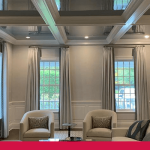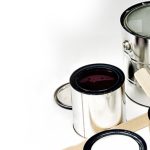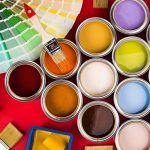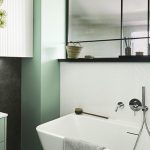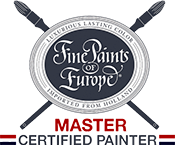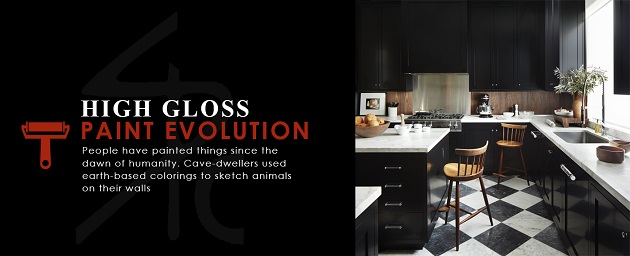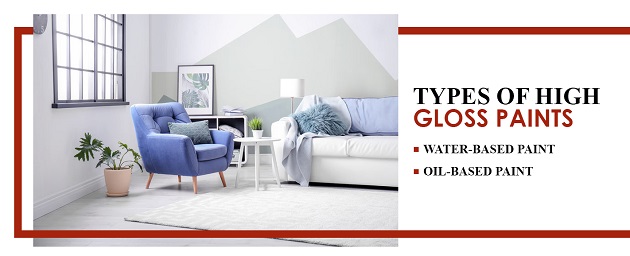Benefits of High Gloss Paint
October 31, 2018
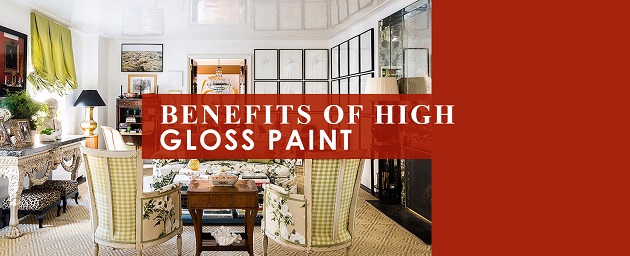
Jump to:
- High Gloss Paint Evolution
- What’s in High Gloss Paint?
- Types of High Gloss Paints
- Benefits and Advantages of High Gloss Paint
- Work With a Professional House Painting Contractor
Paint technology has come a long way in a short time. Many homeowners and residential decorators are moving towards high gloss paints in areas where they’d never before considered using them. Now, more than ever, you can appreciate the benefits of high gloss paint in many more places than your kitchen and bath. Think of painting your ceilings, or even a feature wall, in a stunning high gloss sheen with deep, light-reflecting hue. Or consider giving your doors, millwork and cabinets an outstanding high gloss look.
Current advancements in high gloss paint chemistry allow seamless application and a flawless finish. At one time, that was nearly impossible with high gloss finishes. However, meticulous preparation is still vitally important. So is using the right application tools, and that’s often best left to professional house painters.
High Gloss Paint Evolution
People have painted things since the dawn of humanity. Cave-dwellers used earth-based colorings to sketch animals on their walls. Ancient Egyptians were master painters, perfecting high gloss looks with paints as well as with glass and stone. Medieval Europeans formed painters’ guilds, and they restricted access to entering the painting trade unless a craftsman served a lengthy apprenticeship. That particularly mattered in applying high gloss products.
When Europeans began settling America in the 1600s, they brought painting skills and materials with them. High gloss paints weren’t a novelty by then. In fact, high gloss sheens were the most traditional paint finishes available. In historic America, many folks demanded high gloss finishes. One of the main advantages of high gloss paint was to brighten candle-lit rooms. The challenge for colonial Americans was to bring the sheen down. Early paint technologists didn’t have the ingredients or knowledge to dampen the glow and still have their paints perform properly.
Paints evolved over the past few centuries, but they still serve the same general purpose — to protect surfaces, enhance their appearance and effectively reflect light. Today, we know there isn’t a right and wrong place to use high gloss paint. But, there certainly are right and wrong ways to apply it. That’s why hiring a professional painter is often the best choice.
What’s in High Gloss Paint?
To appreciate the benefits and advantages of using high gloss paint, you might find it helpful to know what’s in it. Paint gloss or sheen is the measure of the finished surface’s ability to reflect or diffuse light. Gloss paints shine because their finish is mirror-like. Gloss surfaces are exceptionally smooth with few microscopic irregularities to diffuse or spread light on an angular pattern.
Flat surfaces, on the other hand, are rough and bumpy when you examine them closely. Instead of reflecting or radiating light back on a direct angle, matte surfaces break light waves into diffuse patterns. Your eye doesn’t catch the reflected rays from flat or low-sheen surfaces the way it does with high gloss paints.
Paint manufacturers offer a range of sheen options in which they measure gloss by percentages. This rating system has been around a long time, and it’s well-described in a 1930s publication by the Journal of Research of the National Bureau of Standards. They describe “gloss” as the surface light reflecting properties and “glossiness” as the appearance resulting from the surface’s power to reflect light. In percentages, here’s how the general sheen categories rate:
- Flat paints contain one to nine percent gloss ability
- Low sheen paints have 10 to 25 percent gloss
- Eggshell paints have 26 to 40 percent gloss
- Semi-gloss paints have 41 to 69 percent gloss
- High-gloss paints have 70 percent and above gloss ratings
In chemical terms, high gloss paints have a much higher proportion of resins than pigments. High resin quantities allow paint to flow more smoothly and evenly than low resin paints. This proportion keeps the paint’s pigment particles low and embedded within the resin coating, resulting in a highly-reflective gloss surface that reflects light and gives the painted surface a strong glossiness.
While we’re on the subject of paint chemistry, let’s take a quick refresher on what goes into a can of paint. Not all paint mixtures are created evenly. That’s especially true when you range from the flat end of the scale to the high gloss side. Here are the four components you’ll find in every paint mix:
Solvents: This is the liquid base you’ll find the other ingredients suspended in. Today’s paints have two solvent types. One is oil or what’s now called alkyds. The other is water. At one time, oil-based paints were the only way to get high gloss reflection. That’s no longer the case, as water-based paints now give excellent high gloss returns.
Pigments: Paint mixtures get their color from pigments. Pigments range from white which is the absence of color to black which is the presence of all colors. Pigments follow a gray scale from light to dark. They also range in granule size which affects their ability to lay low in resins and give that smooth, high gloss sheen.
Resins: Resins bind pigments together within solvents. Paint manufacturers use a wide variety of resin products, and this depends on how they want the finished paint product to stand up. Generally, stronger resins provide a tougher surface. They also contribute the final gloss condition on the finished surface.
Additives: This is where paint chemistry gets complicated. While you only have two options for solvents and a predictable variety in pigment colors, there are all sorts of additives you can put in paint. Some additives add to durability. Some affect drying time, temperature tolerance and moisture resistance. Other additives contribute to how shiny or dull a finished surface becomes.
Types of High Gloss Paints
Not every high gloss surface is actually paint. If you look at a gleaming baby grand piano, for instance, that’s not paint you’re seeing — it’s lacquer. That’s a different chemical and application process than paint. There was a time when lacquer finishes were popular in homes, but that was before paint technology could match the durability and light reflectiveness of lacquers.
The problem with lacquer finishes is applying them. Your sub-surface must be flawlessly smooth and free of any dust, grit or imperfection. Otherwise, impurities will show through, and the final product will be blemished. Lacquer finishes are usually sprayed on which requires extensive prep time. There is also an overpowering smell with lacquer products.
If you’re looking for a modern high gloss finish, the only practical way to go is with a quality paint. Of course, getting the perfect sheen with paint requires the proper preparation and application as well. Paint technology has made it easier for DIY-ers to achieve a smooth, shiny finish, but only a professional knows all the little things necessary to create a truly flawless surface.
Let’s look closer at the two paint bases:
Water-based paint:You’ll often hear water-based paints called latex. That’s usually wrong because latex is a rubber product and it’s rarely used as a paint additive these days. When latex additives were popular, latex reacted badly with most oil-based solvents. It cooperated well with water, though, and that’s where the term latex paint came from. Nowadays, water-borne solvents are highly sophisticated and can create high gloss sheens.
Oil-based paint: Again, we have conflicting terms. Originally, most paints were oil-based with either a petroleum or vegetable solvent. Linseed oil was exceptionally popular as it took pigments, resins and additives well and flowed to an even surface. Linseed oil, like petroleum oil bases, dried hard and shiny. However, oil-based paints had a long curing time and were difficult to apply in low temperatures. Synthetic oils called alkyds slowly replaced true oils. Now, you’ll usually find alkyds behind a paint labeled oil-based.
Here at Shoreline Painting we’re a Fine Paints of Europe Master Certified Painter and recommend Fine Paints of Europe Hollandlac Brilliant as the best quality high gloss paint on the market. It’s perfect for both interior and exterior jobs when top quality is desired.
Benefits and Advantages of High Gloss Paint
If you’re considering using a high gloss paint in your next project, you’re probably looking for its reflective effect rather than its performance. Appearance is definitely important, however, you should aso consider what you’re expecting your painted surface to endure. Historically, painters applied high gloss products to high traffic areas. They wanted these exposed surfaces to stand up to heavy wear and tear.
Durability is still a main factor in choosing your paint sheen. Without a doubt, high gloss and semi-gloss paints are tougher and stand up to abuse better than flat, eggshell and low-sheen surfaces. You should match your desired appearance with your expected performance. Much of your decision depends on what surface you’ll be painting. Here are typical applications where you’d benefit by using high gloss paint:
1. High Humidity Areas
Kitchens and bathrooms have always been prime targets for walls and trim painted in high gloss sheens. Brand-name paint producers offered specific paint blends labeled “Kitchen & Bath” which were actually generic paint blends with a high gloss shine. There were two reasons for using high gloss and semi-gloss paint in “wetrooms.” One was to seal wood and drywall to resist moisture penetration. The other was to make cleaning easier as smooth, high gloss surfaces are easier to wipe down and retain their original luster. This holds true today, but you can extend your reach of high gloss paints well beyond your bath, kitchen or laundry room.
2. High Traffic Areas
Entryways, halls, stairs and floors are always serious candidates for high gloss paint. That’s due to the hard shell that high gloss products exhibit when cured. Just as high gloss surfaces resist water, dirt and contaminants, these tough finishes stand up to high traffic. High gloss paints also resist bumps, nicks and scrapes from moving items like furniture and even pets. You can’t get the strength and durability of high gloss products with any other paint type.
3. Accent Features
If you want to attract attention, the most effective device is a coat of high gloss paint. Have you noticed how many front doors glow from reflected light? That’s not by accident or a simple protective device. Smart designers know that a front door is a statement, and nothing speaks louder than a bold coat of high gloss paint. The same goes for interior features. Balustrades, crown molding and fireplace mantles wouldn’t be the same without their characteristic, high gloss shines. You can take this effect further with high gloss finishes on accent features like ceilings, walls and cabinetry.
4. Bold and Drastic Colors
It’s one thing to make a decorating statement with color. It’s entirely another thing to let bold and drastic colors shout out by using a high gloss sheen. Bright, reflective surfaces have a dramatic effect, both with natural daylight and artificial illumination after dark. White is always the classic mainstay for millwork and casings. And, white hues naturally glow with high gloss finishes. But you can achieve astounding results by using deep blues, vivid greens and feisty reds in features like walls, ceilings and screened dividers. All it takes is some imagination and the courage to pull it off.
5. Fun and Inventive Ways
Watch any kid respond to color. You’ll notice they go for the bright, shiny stuff every time. Perhaps children know something adults have forgotten — that high gloss surfaces are fun, especially when used in inventive ways. Your kids’ rooms are the place to start, particularly with furniture. They’ll love seeing a mirror-like reflection off dressers and bunk beds. Consider a high gloss wall in the playroom. Not only does high gloss brighten the area, it also makes it far more durable against bouncing balls and falling block towers.
Probably the only thing holding you back from going wild with high gloss paint is yourself. If you’re a cautious sort with traditional tastes, try sticking with conservative, muted colors but add the drama of a glossy shine. If you’re thinking of venturing in a bolder direction, a bold color can stand out even more with a reflective sheen. No matter your style, high gloss paint is the product for you.
Work With a Professional House Painting Contractor
Shoreline Painting & Drywall is your go-to professional house painting contractor in Fairfield County, Conn., and Westchester County, N.Y. For 35 years, Shoreline has painted homes for thrilled clients by using the right mix of talented artisans, top tools and five-star eco-friendly products. That includes gallons upon gallons of high gloss paint.
At Shoreline Painting, we have an integrated and structured management team. We approach each project with pride and integrity. Our workmanship is first class, and we stand behind our work with a solid guarantee. Backing up our guarantee is our insurance, bonding and contractor’s license.
If you’re ready for professional interior or exterior house painting, Shoreline Painting is here for you. We serve Greenwich, Riverside, Norwalk, Stamford, New Canaan, Westport and Darien as well as New York City. Our team of over 70 highly-dedicated craftspeople is here and ready to help you paint, including taking on bold and innovative high gloss jobs.
For more information on a top quality paint job with Fine Paints of Europe Hollandlac Brilliant high gloss paint call Shoreline Painting & Drywall today at 203-302-1086. You can also reach us through our online contact form.
Recent Posts & Guides
